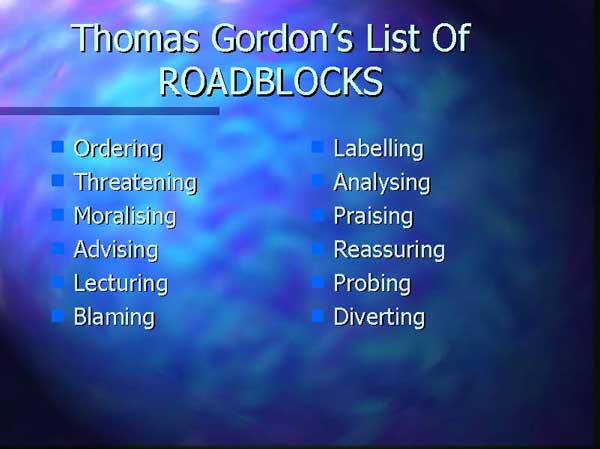WordPress database error: [Table 'adding_b51201.wp_SBConfiguration' doesn't exist]select * from wp_SBConfiguration where id='1'
Welcome to Module 3.2 Return to Dashboard
If you check the goals you set for this course, the chances are that most of your goals actually fit in the areas of that square diagram where you own a problem. Surprisingly, we’re going to start learning more skills in the area where you feel Okay and the other person owns a problem. This will make more sense later, but basically, it’s easier to learn the Assertive and Conflict Resolution skills once you already know the skills for helping someone else solve their problem.
So firstly, lets check, in the contexts you are wanting to use Transforming Communication, how would you know that someone else had a problem; what sensory specific cues or clues would you get that they were not happy?
Write down your answer, to practice your understanding of the concepts learned so far.
All of us come across situations, in our job or at home, where someone else is trying to solve a problem. Most of us have attempted to be helpful in those situations, and most of us want to make sure that our help doesn’t prevent the other person from learning to solve their own problems; we want to support them, but to support them to solve problems and reach goals themselves.

Thomas Gordon points out 12 ways that we’ve all probably used in an attempt to help someone else, but that are high risk responses. He calls them roadblocks. To give you an idea what these twelve ways are like, I’d like you to imagine that you have some problem. It’s important to think of a totally imaginary problem for this exercise – like “Your best friend won’t talk to you since you stole all their money” or “My boss complains that I don’t have the correct accent.” If those ones are true for you, find something else.
Say a sentence to yourself about your imaginary problem and read the responses below.
1. Ordering “Just keep quiet about that here. I’m trying to teach this class”
2. Threatening “Well, if you carry on complaining about it in here, you’ll be in
even worse trouble.”
3. Moralising “You’re old enough to deal with this” “You should be able to get over this by now.”
4. Advising “Okay, here’s what you should do….” (suggest something fairly
absurd, but vaguely related to the problem)
5. Lecturing “Yes, I was reading some research on that the other day. It
said that 95% of people that won’t sort out this problem will die younger.”
6. Blaming “There’s no-one but you to blame for that is there. It’s your own
fault for being so stupid.”
7. Labelling “There’s always one moaner in the class isn’t there. Always one
person who’s a hard done by complainer.”
8. Analysing “I wonder if you’re really saying that because you want me to feel sorry for yourself.”
9. Praising “Well good for you for being sensitive enough to be aware of that
problem. Someone who’s that sensitive will also be able to stop bothering me now.”
10. Reassuring “Hey, don’t worry about it. It will all come right eventually. In fifty years who will worry?”
11. Probing “How long have you had this problem? Why did you bring it up now? Do you always worry so much?”
12. Diverting “Yes, that reminds me of something that I’ve been noticing lately….”
If you imagined your problem and had a sentence in your mind, reading these answers: how was it to be roadblocked?
The use of roadblocks is well intentioned, and may even work sometimes, but carries a high risk that the other person will feel put down, told they’re too dumb to sort it out, ignored, or blamed. In the No-Problem area, many of these roadblocks could well be safe to use (people often pay good money for advice, moralising, etc, and you certainly want to be able to praise people for their positive behaviours).
But in the area where the other person owns a problem, these same skills, if used as a first resort, can cut off the conversation very quickly. As a rule, the stronger the other person’s feelings about their problem, the more risky the roadblocks are. Unfortunately, these 12 methods cover most of what we can say!
Would it be useful to develop more skills with what’s left?….
The first thing to notice is that successful helping involves some non-verbal responses such as rapport building. These non-verbal components of helping are called Attending.
In the video here we’ve demonstrated bad attending skills and what changed when we used good attending: